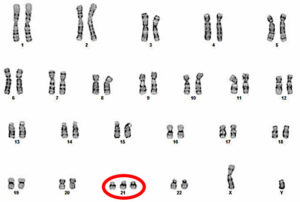In 1958, following advances in genetic research, the British scientist Pat Jacobs and French scientist Jérôme Lejeune discovered the syndrome’s chromosomal cause. This is when DS started being recognized as a genetic condition that can cause or exacerbate health problems.
People with Down syndrome present specific physical characteristics, delays in their development, and different intellectual ability. The health problems that affect them are the same as can happen to anyone, but there is a greater incidence of concerns such as heart disease, respiratory problems, leukemia and Alzheimer’s disease. They may also present sleep apnea, a loss of muscle tone, and thyroid problems that can lead to weight gain or obesity.

Down syndrome occurs in all ethnicities and genders and at all socioeconomic levels. Although the rate of babies born with DS occurs with higher frequency among mothers over 40, the birth of children with trisomy 21 happens unpredictably, at an average of 1 in every 750 births. Parents may find it important to note that there is no known correlation between parental characteristics or activities and the occurrence of Down syndrome.
Biologically speaking, there are three known causes for Down syndrome. In 95% of cases there is the presence of an extra chromosome 21 in the cells, also lending the syndrome the name trisomy 21 (T21). The other causes are known as mosaicism, where some cells in the body have an extra copy of chromosome 21 while others have the typical number, and Robertsonian translocation, where an extra chromosome 21 is fused to another chromosome.
Treatments exist for most of the health problems related to Down syndrome. A multidisciplinary therapeutic approach is essential, with caregivers working together to support the individual in an integrated fashion. Even though symptoms or behaviors have biological causes, treatment can often be more effective when combined with other measures, such as pedagogical approaches.
What causes differences in ability in individuals with Down syndrome has not yet been determined. Each person’s genetic pattern, their habits, and the environment in which they live determine the physical and developmental differences among individuals with DS.
Because there are helpful interventions and programs of care, it is important to emphasize that people with Down syndrome, when adequately cared for and stimulated, have the potential to live a healthy life, with full social inclusion and a high degree of autonomy.
The Importance of Investing in Down Syndrome Research
The majority of treatments for the health problems experienced by people with Down syndrome were developed through research with people without trisomy 21. Therefore, it is important to discover how individuals with DS react to certain treatments.
The scientific goal of the Alana Down Syndrome Center is to expand the understanding of the syndrome’s cellular and biological mechanisms and, consequently, improve treatments and therapies for DS, leading to improved quality of life, autonomy and societal inclusion.


